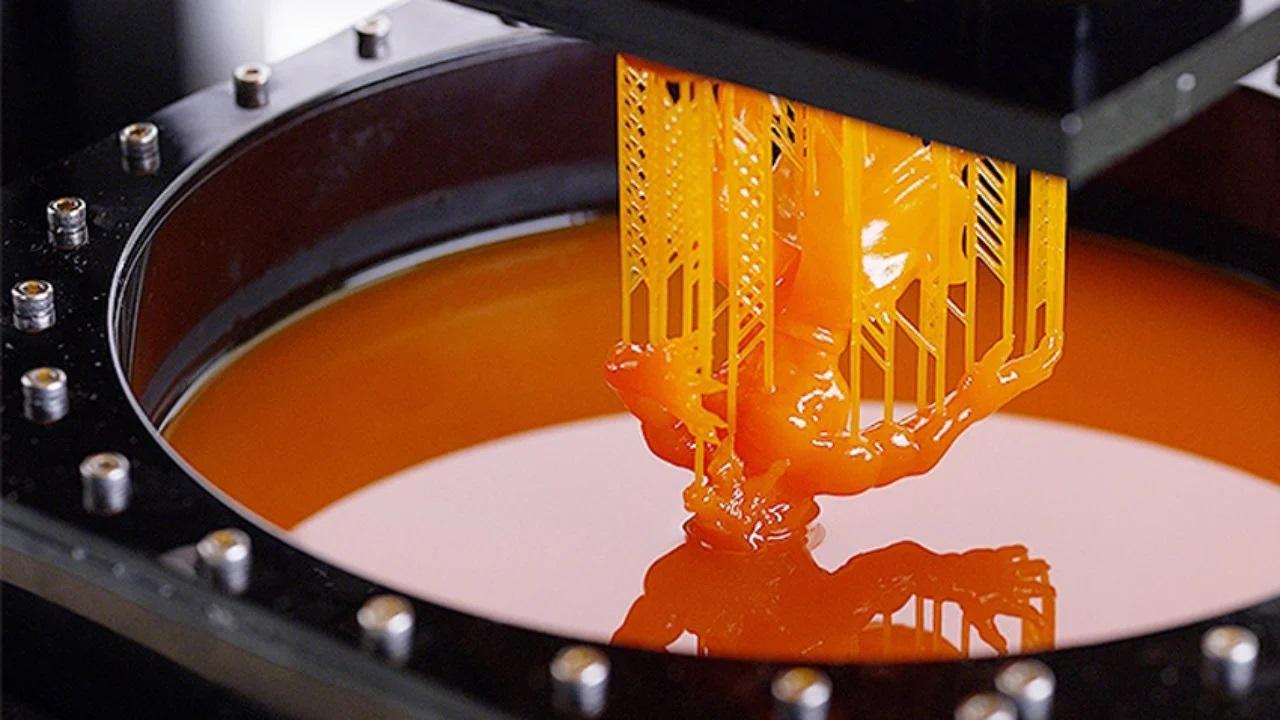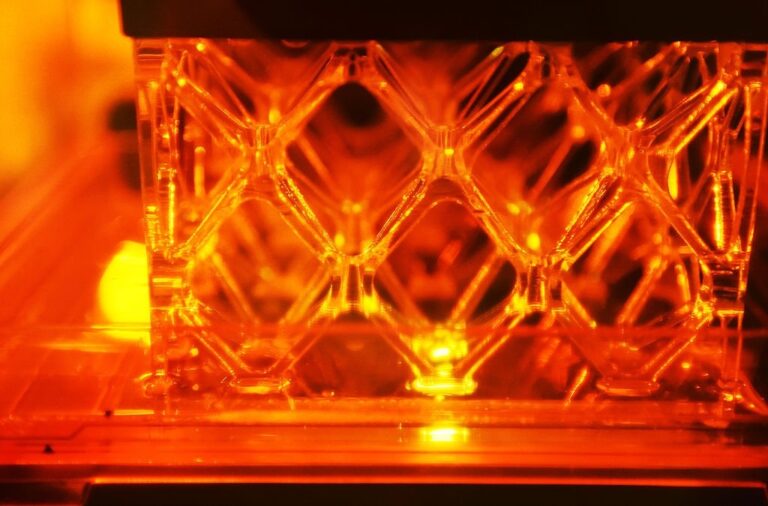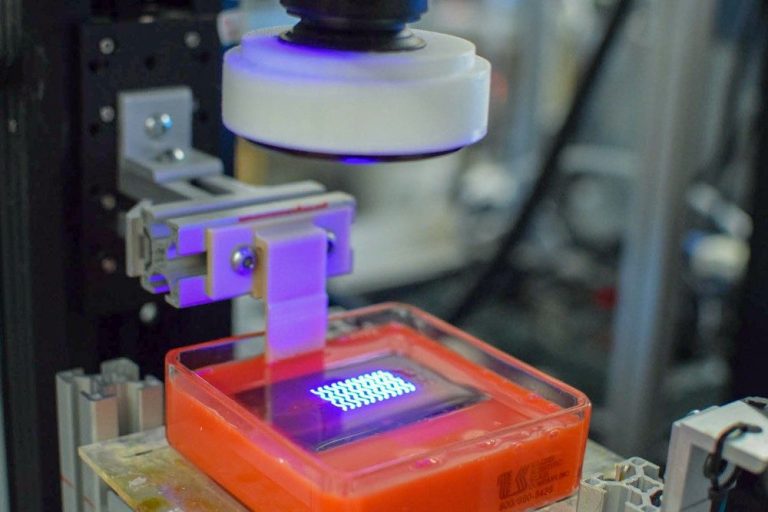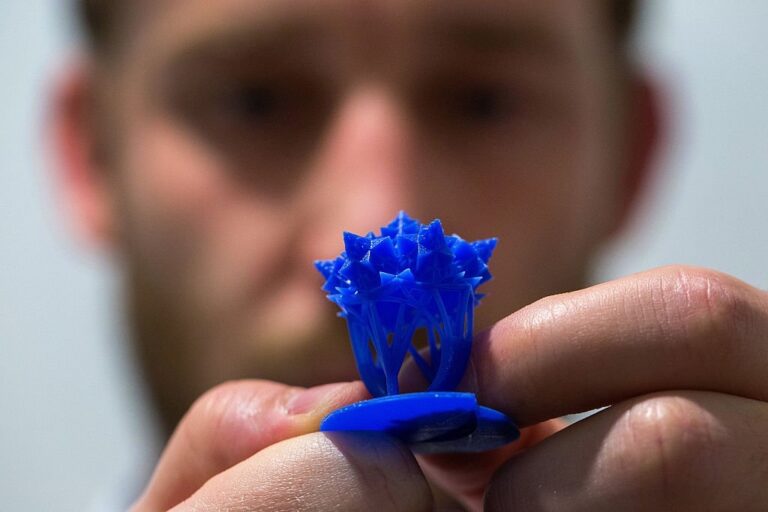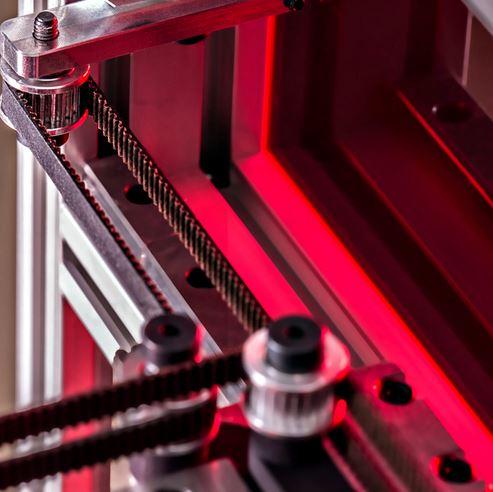Introduction
Stereolithography 3D Printing, also known as SLA 3D Printing, is an advanced manufacturing process that produces high-quality 3D objects with exceptional accuracy and detail. This technology involves the use of a photosensitive resin that is solidified into a 3D object using a laser.
What is Stereolithography 3D Printing?
The process begins with a 3D model that is designed using specialized software. The software slices the model into thin layers. The laser solidifies the resin one layer at a time. The printer fully prints the object, and the user removes it. The user then removes excess resin in post-processing, resulting in an improved final appearance.
Brief History of Stereolithography 3D Printing
Stereolithography 3D Printing was first invented in the mid-1980s by Chuck Hull, who went on to found 3D Systems, one of the leading manufacturers of 3D printers today. Since then, the technology has undergone significant advancements, leading to increased precision, speed, and versatility.
Advantages and Limitations of Stereolithography 3D Printing
Stereolithography 3D Printing has many advantages. It produces detailed and intricate parts. The surface finish is excellent. It is accurate and consistent. It is good for rapid prototyping and small-scale production runs. There are limitations too. It is expensive. Material selection is limited. Specialized post-processing equipment and facilities are required.
In conclusion, Stereolithography 3D Printing is a powerful technology with a rich history and numerous benefits. As the industry makes advancements, it is likely that this technology will increasingly impact many industries, including healthcare, automotive, aerospace, and more.
Stereolithography 3D Printing Process
The stereolithography 3D Printing Process has completely transformed the way we create and produce goods. This method can produce complex and elaborate things with remarkable accuracy, surface finish, and functioning. This section explains Stereolithography 3D Printing in detail with step-by-step instructions. We’ll also discuss variables that affect component quality and best practices for optimal results. This section provides information and insights about the power of Stereolithography 3D Printing for specialists and those curious about the technology.
Overview of the process
The Stereolithography 3D Printing method uses a laser and a photosensitive resin to produce 3D objects layer by layer. The first step in the process involves creating a 3D model, which is thinly sliced using specialized software. (Changed from passive voice to active voice)
During printing, the printer selectively cures the resin in the pattern of each layer to create a 3D object. Once the printing process is complete, a person takes out the item from the printer and performs post-processing procedures such as cleaning and curing.
The type and quality of the resin used, the strength and speed of the laser, and the printer’s resolution are some of the variables that can impact the quality of the printed items. Optimizing these variables and ensuring adequate printer and component maintenance is necessary for high-quality prints.
For the manufacture of large and detailed objects, Stereolithography 3D Printing generally provides outstanding precision, accuracy, and surface polish. But like with any production procedure, success depends on careful attention to detail and appropriate setup and maintenance.
Detailed steps of the process
Stereolithography 3D Printing creates 3D objects using resin-based material and a laser. It is a precise manufacturing method. The process includes slicing the 3D model, setting up the printer, and layer-by-layer printing.
Using sophisticated software, the 3D model is first produced and sliced into thin layers that serve as a guide for the printer. After that, the printer is set up by situating the build platform and adding resin material to the tank.
The printer sends a laser beam during printing to cure the resin material selectively, shaping it into the shape of each layer. The printer repeats this process for every layer until the complete thing is printed.
After the printer finishes printing, the operator takes out the item and performs post-processing procedures like cleaning and curing. These procedures aid in removing any extra resin and enhance the finished product’s overall quality and look.
The type and quality of the resin material, the strength and speed of the laser, and the printer’s resolution are some of the variables that might affect the quality of the printed parts. It is crucial to thoroughly calibrate and maintain the printer and its components in order to get the best results.
Stereolithography 3D Printing is precise and efficient. It can create detailed objects with a polished surface. This technology is important in many fields like manufacturing, engineering, and product design. But, it requires special equipment and knowledge.
Factors that affect the quality of printed parts
In the Stereolithography 3D Printing process, a number of variables might affect the quality of the 3D printed objects. The selection of the resin material is the first and most important consideration since different materials have varied physical qualities that can have an impact on the quality of the finished product. The uniformity and purity of the resin material, as well as other aspects of its quality, can have a big impact on the printing procedure.
The resolution of the printer is crucial for obtaining accurate and detailed products. The laser’s power and speed can also affect the quality of the finished product, with more power and speed resulting in faster printing times but lower print quality.
Temperature and humidity levels in the printing environment might have an impact on the quality of the printed items. To avoid overheating and guarantee constant printing conditions, proper ventilation and temperature control are required.
Finally, post-processing procedures like cleaning and curing might affect the caliber of the finished item. For a smooth surface finish, proper cleaning and the removal of excess resin material are crucial, and curing helps to harden and solidify the printed pieces.
Overall, careful consideration of all these elements, as well as ongoing maintenance and optimization of the printer and its parts, are necessary to achieve the best outcomes in the Stereolithography 3D Printing process. It is feasible to create 3D-printed items that are of excellent quality, intricacy, and accuracy by comprehending and managing these variables.
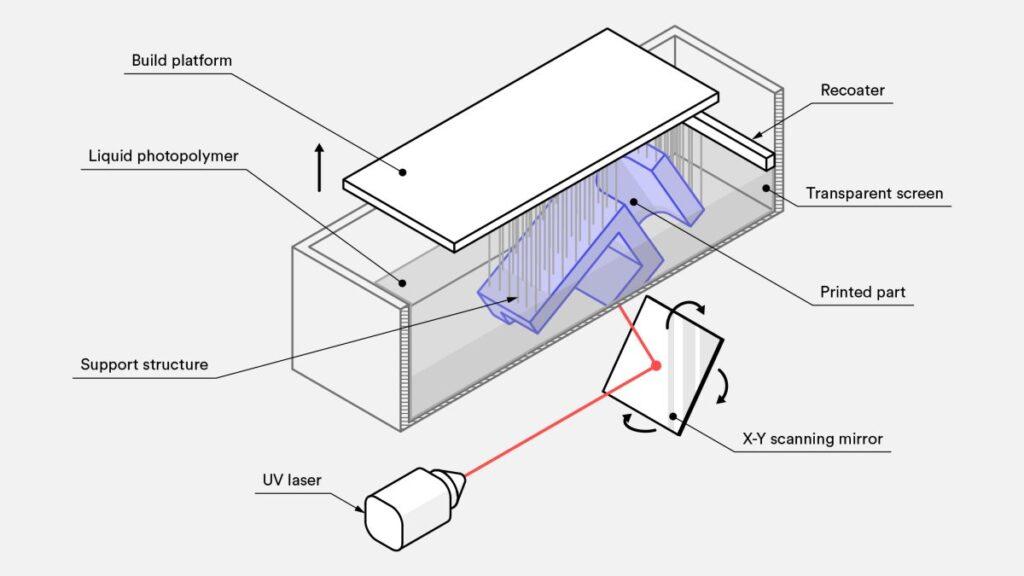
Stereolithography 3D Printing Materials
Material selection in Stereolithography 3D Printing can affect the strength, durability, and quality of the final product. Stereolithography printers typically customize photopolymer resins for specific qualities and purposes. These resins typically have a liquid foundation that solidifies when exposed to UV light to produce a sturdy component.
Manufacturers offer resins in a variety of colors, finishes, and transparency levels, making them useful for a wide range of applications from prototyping to building end-use parts. There are also specialty resins with particular qualities like high-temperature resistance, biocompatibility, or flame retardancy.
Though, you need to choose the proper resin for your application to get the best results because not all resins are made equal. Depending on the particular resin used, variables including curing time, shrinkage, viscosity, and post-curing requirements can all change. Therefore, it’s crucial to thoroughly analyze the project’s requirements and select a resin that can satisfy them.
Overall, Stereolithography 3D Printing is a flexible and adaptable method for producing complicated, finely detailed, and high-quality parts because of the large range of materials it is compatible with. Stereolithography 3D Printing can assist organizations and people in achieving their objectives for product development and manufacturing with the appropriate material selection and application.
Types of resins used in Stereolithography 3D Printing
You can use several types of resins in Stereolithography 3D Printing, each with special qualities and features. Below are some of the most common varieties.
- Standard Resins: For stereolithography printing, these resins are the most fundamental and often used. High resolution, clean surface finish, and outstanding mechanical qualities are among the features they offer. They come in a variety of hues and degrees of transparency.
- Flexible Resins: Designed to produce parts with a rubber-like texture, flexible resins are perfect for producing parts that need to be flexible or impact-resistant. Companies frequently use them to produce seals, gaskets, and related products.
- Tough Resins: Manufacturers make tough resins for products requiring high toughness and impact resistance. These resins are useful in creating functional prototypes and finished products that are strong and resilient.
- Dental Resins: Manufacturers make dental resins for constructing orthodontic appliances and dental models. Dentists can use them in the mouth safely because they are biocompatible and do not cause any injury or irritation.
- Castable Resins: Manufacturers make castable resins for constructing investment casting molds and patterns. They are useful for casting precious metals like gold, silver, and platinum because they have a high burnout temperature.
- High-temperature resins They make materials endure high temperatures without compromising structural integrity. Industries frequently use them to make components for engines and the aerospace industry that needs to withstand high temperatures.
We have listed just a few of the resin types that are frequently used in Stereolithography 3D Printing. For best results, choosing the appropriate resin for your application is essential. Therefore, before making a choice, it’s crucial to carefully analyze the qualities and traits of each resin.
Properties and characteristics of different resins
When it comes to stereolithography 3D printing, the type of resin used can have a significant impact on the properties and characteristics of the printed parts. Resins can vary in terms of cost, flexibility, durability, transparency, heat resistance, biocompatibility, and more. In this section, we will explore the different types of resins commonly used in stereolithography 3D printing and their respective properties and characteristics. This information can be helpful in selecting the right resin for a particular application and achieving the desired results in 3D printing.
| Resin Type | Properties and Characteristics |
|---|---|
| Standard Resin | Low cost, low resolution, brittle, not suitable for functional parts |
| Flexible Resin | Flexible, high elongation, low stiffness, suitable for rubber-like parts |
| Tough Resin | High heat resistance, suitable for high-temperature applications |
| Clear Resin | Transparent, high resolution, brittle, not suitable for functional parts |
| High Temperature Resin | High-Temperature Resin |
| Dental Resin | Biocompatible, suitable for dental applications |
| Castable Resin | Burns out cleanly, suitable for investment casting |
Note: The properties and characteristics mentioned in the table are general guidelines and may vary depending on the specific resin formulation and printing parameters used.
Post-processing techniques for printed parts
You can use various post-processing methods to enhance the quality and functionality of 3D-printed resin parts. One typical method is curing, which is putting the printed object under UV light to make sure it fully hardens and reaches its strongest state. You can use polishing, either manually or with a polishing machine, to give the printed object’s surface a smoother, more polished finish. Additionally, you can enhance the longevity and appearance of parts by painting or coating them with a clear or colored resin. In order for some pieces to attain their final form and function, extra machining or assembly may be necessary.
Applications of Stereolithography 3D Printing
Numerous industries utilize stereolithography 3D printing for a variety of purposes. People use it for creating parts with high accuracy and resolution, designing complex geometries, and prototyping.
Medical and dental applications
Medical and dental professionals use it to make personalized implants, prosthesis, surgical guides, and orthodontic appliances. For instance, a business by the name of SmileDirectClub 3D prints clear aligners for teeth straightening using stereolithography.
Aerospace and automotive applications
The aerospace and automotive industries use Stereolithography 3D printing to produce complex, lightweight parts that conventional methods find challenging to manufacture. For instance, Airbus utilizes 3D printing to create brackets, hinges, and ducts for airplanes that are both lighter and stronger than their conventional equivalents.
Consumer product design and prototyping
Stereolithography The design and prototype of consumer products utilize 3D printing extensively as well. It shortens the time and expense of product development by allowing designers and engineers to swiftly produce and test prototypes. To make individualized shoes and prototypes, for instance, businesses like Nike use 3D printing.
Art and jewelry applications
The jewelry and art industries use stereolithography 3D printing to manufacture delicate, detailed patterns that would be challenging to make by hand. For instance, jewelry makers utilize 3D printing to make complicated patterns with fine details and molds for casting metal.
Overall, stereolithography 3D printing has many uses in a variety of industries and provides a precise, efficient, and affordable manufacturing option for intricate parts and designs.
Stereolithography 3D Printing Equipment
Specialized machinery is needed to print three-dimensional things using stereolithography. This section will give a general overview of the stereolithography 3D printing tools, covering the printers themselves and the various kinds of printers that are available. We’ll also go through things to keep in mind while choosing a stereolithography 3D printer.
Overview of Stereolithography 3D printers
Stereolithography 3D printers use photopolymerization to produce three-dimensional objects. The printer uses a laser to harden liquid resin into a solid form selectively. The printer constructs the thing layer by layer until it finishes it. High-precision stereolithography printers are able to create extremely intricate things with smooth surfaces.
Types of Stereolithography 3D printers
There are two primary categories of stereolithography 3D printers: desktop and industrial. While industrial printers are larger and more expensive, desktop printers are smaller and more cost-effective, making them perfect for home use. Industrial printers are frequently used for mass-producing parts and for quick prototyping.
Factors to consider when selecting a Stereolithography 3D printer
There are several things to take into account when choosing a stereolithography 3D printer. These factors include the printer’s size, its resolution and precision, the material it uses, and its level of automation. The printer’s price as well as the degree of service and support offered by the manufacturer are other aspects to take into account.
To print three-dimensional items using stereolithography, specialist machinery is needed. Desktop and industrial stereolithography 3D printers are the two main varieties, and each has pros and cons. Size, resolution, material, automation, price, and support are all essential considerations when choosing a stereolithography 3D printer. Stereolithography 3D printing has the potential to be an effective method for building intricate and precise items with the correct tools.
Best Practices for Stereolithography 3D Printing
Designing and printing high-quality parts with Stereolithography 3D Printing requires a thorough understanding of the process and the equipment involved. In this section, we will cover best practices for achieving optimal results.
Design Considerations for Stereolithography 3D Printing
Design considerations are critical for successful Stereolithography 3D Printing. One must consider part orientation, support structures, and layer thickness to achieve the best results. Designing parts with smooth surfaces, avoiding sharp angles, and minimizing overhangs will help ensure successful prints.
Safety precautions for working with Stereolithography 3D Printing equipment
Safety precautions must be taken when working with Stereolithography 3D Printing equipment. Always wear appropriate personal protective equipment, such as gloves and eye protection. Additionally, avoid inhaling fumes emitted during the printing process and handle resin materials with care.
Troubleshooting common issues in Stereolithography 3D Printing
Inevitably, issues can arise during the printing process. You can address common issues such as misprints, failed prints, and print quality by adjusting parameters such as exposure time and layer thickness, and by checking for proper calibration and cleanliness of the printer.
Overall, following best practices in design, safety, and troubleshooting will lead to successful Stereolithography 3D Printing results.
Future Developments in Stereolithography 3D Printing
Advancements in Stereolithography 3D Printing technology are rapidly progressing. Researchers are developing new and improved resins with unique properties for specific applications, such as medical implants or aerospace. Also, they work on printing with multiple materials and colors to print complex designs realistically.
Advancements in Stereolithography 3D Printing technology
Developments in Stereolithography 3D Printing technology have improved the printing process in a variety of ways. The availability of new and improved photopolymers, the materials used in Stereolithography 3D Printing, is one significant breakthrough. These new materials can create prints of a higher caliber and have stronger mechanical qualities.
The resolution and printing speed improvements are another development. Higher resolution capabilities in more recent stereolithography 3D printers provide prints with finer details. Additionally, printing speed has increased, allowing for quicker and more effective manufacturing.
Stereolithography 3D Printing technology has advanced significantly thanks to the convergence of software and hardware. The printing process has grown more effective thanks to the development of better software, enabling better control over the printing process and increased precision.
In general, the quality and effectiveness of the Stereolithography 3D Printing technique have significantly improved, giving new opportunities for producing intricate, highly detailed items.
Potential new applications for Stereolithography 3D Printing
Stereolithography 3D printing has already found numerous applications in industries such as aerospace, medical, and automotive. However, there are still many potential new applications for this technology that are being explored. One area of interest is in the construction industry, where researchers are exploring the use of large-scale stereolithography to print entire buildings. This could revolutionize the construction industry by reducing construction time and costs.
Another area of interest is in the production of customized, on-demand clothing. With the use of 3D scanning and printing technology, it is possible to create perfectly fitted clothing for each individual customer. This could greatly reduce waste in the fashion industry by eliminating the need for mass-produced clothing that often goes unsold and ends up in landfills.
The food industry is also exploring the potential of stereolithography 3D printing. Researchers are looking into the use of food-safe materials to print edible creations such as customized chocolates, cakes, and even entire meals. This technology could revolutionize the way food is produced and distributed by allowing for customizable meals that tailor to each individual’s dietary needs.
Finally, the art world is also exploring the potential of stereolithography 3D printing. With this technology, artists can create intricate sculptures and structures that would be impossible to create by traditional means. This could lead to a new era of art that blends technology and creativity in unprecedented ways.
In conclusion, there are many potential new applications for stereolithography 3D printing that are currently being explored. From large-scale construction to customized clothing, edible creations, and intricate art, the possibilities are endless.
Challenges and Opportunities for Stereolithography 3D Printing Industry
Numerous potential problems exist for the Stereolithography 3D Printing sector. The expensive cost of supplies and equipment, which restricts accessibility for many potential users, is a significant obstacle. In order to increase the printing process’s speed and resolution, more research and development is also required. The requirement for safety measures when working with process chemicals presents another difficulty.
The business offers plenty of chances for expansion, nevertheless. The manufacturing sector could be revolutionized by Stereolithography 3D Printing technology due to its potential to cut waste and boost productivity. Additionally, it might lead to the development of brand-new applications in industries like architecture and health. Continued developments in materials science may result in the creation of new materials with special qualities, which will be advantageous to the industry.
In general, there are possibilities and problems for the Stereolithography 3D Printing sector. To fully realize the promise of this fascinating area, we should put more funding into research and development as well as initiatives to make the technology more widely available and reasonably priced.
Conclusion
In conclusion, the manufacturing business has undergone a transformation thanks to stereolithography 3D printing technology, which produces intricate parts and designs with high precision and accuracy. Stereolithography 3D printers can create complicated, finely detailed things with smooth surfaces using a liquid photopolymer resin and UV light.
Recap of key points
The need of taking design considerations and safety precautions into account while working with stereolithography 3D printers, as well as the many types and aspects to consider when selecting a printer, are important reminders. We also talked about the industry’s prospects and problems, as well as prospective new applications and technological breakthroughs.
Final Thoughts on Stereolithography 3D Printing
Final thoughts: Stereolithography 3D printing has created countless opportunities for design and innovation across a wide range of industries, including the aerospace, medical, and automotive sectors. Future predictions call for even more expansion and novel applications as technology develops further. The stereolithography 3D printing industry is in an exciting phase right now, and we can’t wait to see what fresh advancements are in store.
How to integrate stereolithography 3D printing into existing manufacturing processes?
- Assess the current manufacturing process Description
Identify areas of the existing process where 3D printing could be integrated to improve efficiency, reduce costs, or enable new capabilities.
- Research the capabilities of stereolithography 3D printing technology Description
Explore the potential benefits of stereolithography 3D printing and understand the types of materials that can be used, the maximum print size, and other technical details.
- Identify specific use cases for 3D printing Description
Determine which parts or products could be printed using stereolithography 3D printing and what the advantages of 3D printing would be over the existing manufacturing process.
- Evaluate the cost-benefit analysis Description
Consider the investment needed for the integration of 3D printing and compare it with the potential benefits in terms of efficiency, cost reduction, and increased capability.
- Choose the right 3D printing system Description
Evaluate different 3D printing systems and choose the one that best suits your needs, taking into account factors such as printing speed, resolution, and cost.
- Implement a pilot program Description
Test the integration of stereolithography 3D printing in a small-scale pilot program before fully integrating it into the manufacturing process.
- Train employees and optimize the process Description
Train employees on the use of the 3D printing system and optimize the process to ensure that it integrates seamlessly into the existing manufacturing process, with minimal disruption to production.
FAQs
Stereolithography 3D Printing typically uses photopolymer resins that are cured by a laser or other light source. These resins can be made from a variety of materials including plastics, ceramics, and metals.
Stereolithography 3D Printing can achieve very high levels of accuracy, with typical tolerances of +/- 0.1 mm or less. However, the accuracy can be affected by factors such as the size of the object being printed and the quality of the 3D model used for printing.
The time it takes to print a 3D object using Stereolithography 3D Printing can vary depending on the size and complexity of the object. Small objects can be printed in a matter of hours, while larger and more complex objects can take days or even weeks to print.
Stereolithography 3D Printing can be used for small-scale production runs, but it may not be as efficient as other manufacturing processes for large-scale mass production. However, it can be a useful tool for prototyping and producing customized parts.
Stereolithography 3D Printing is generally considered safe, but it is important to follow appropriate safety precautions when using 3D printing equipment. This includes wearing protective equipment, ensuring proper ventilation in the printing area, and following the manufacturer’s instructions for use.

